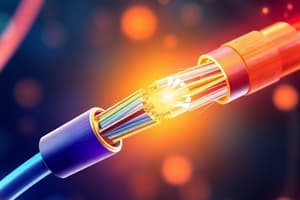Podcast
Questions and Answers
Which of the following is NOT a type of wireless transmission media?
Which of the following is NOT a type of wireless transmission media?
- Satellite
- Infrared
- Coaxial cable (correct)
- Microwave
What is a characteristic of wireless transmission media compared to wired transmission?
What is a characteristic of wireless transmission media compared to wired transmission?
- Is more secure against interference
- Typically allows for greater mobility (correct)
- Requires physical cables for data transfer
- Transmits data faster over long distances
Which wireless transmission method is primarily used for short-range communication?
Which wireless transmission method is primarily used for short-range communication?
- Satellite
- Infrared (correct)
- Microwave
- Coaxial cable
What is the primary means of data transmission in wireless communication?
What is the primary means of data transmission in wireless communication?
Which of the following best describes a disadvantage of wireless transmission media?
Which of the following best describes a disadvantage of wireless transmission media?
Which wireless transmission technology uses satellites for communication?
Which wireless transmission technology uses satellites for communication?
Which option is commonly associated with the use of microwave transmission?
Which option is commonly associated with the use of microwave transmission?
In wireless communications, which technology is most affected by physical obstacles such as buildings?
In wireless communications, which technology is most affected by physical obstacles such as buildings?
What characteristic of microwaves allows them to transmit over long distances?
What characteristic of microwaves allows them to transmit over long distances?
Which type of infrared communication requires a clear line of sight between the transmitter and receiver?
Which type of infrared communication requires a clear line of sight between the transmitter and receiver?
What is the primary purpose of a modem in data communication?
What is the primary purpose of a modem in data communication?
Which transmission medium uses a satellite located in space for data communication?
Which transmission medium uses a satellite located in space for data communication?
What happens to data transmission if there is an obstruction in line of sight for infrared communication?
What happens to data transmission if there is an obstruction in line of sight for infrared communication?
Which of the following is NOT a type of unguided transmission medium?
Which of the following is NOT a type of unguided transmission medium?
What is the role of a router in a network involving a modem?
What is the role of a router in a network involving a modem?
What type of transmission media primarily uses unblocked direct lines between points?
What type of transmission media primarily uses unblocked direct lines between points?
What is a key advantage of twisted pair cables?
What is a key advantage of twisted pair cables?
Which of the following is a disadvantage of fiber optic cables?
Which of the following is a disadvantage of fiber optic cables?
What makes coaxial cables less vulnerable to interference compared to other types?
What makes coaxial cables less vulnerable to interference compared to other types?
Which statement about fiber optic cables is true?
Which statement about fiber optic cables is true?
What is one reason twisted pair cables are mainly used for voice and data?
What is one reason twisted pair cables are mainly used for voice and data?
Which of the following applications is suited for coaxial cables?
Which of the following applications is suited for coaxial cables?
Why might one opt for fiber optic cables over twisted pair cables?
Why might one opt for fiber optic cables over twisted pair cables?
What is a disadvantage of coaxial cables?
What is a disadvantage of coaxial cables?
Flashcards
Transmission Media
Transmission Media
The physical material data travels through from one point to another.
Cabled Transmission Media
Cabled Transmission Media
Uses physical wires like twisted pair, fiber optic, or coaxial cable to transmit data.
Wireless Transmission Media
Wireless Transmission Media
Uses radio waves or other electromagnetic signals to carry data without physical wires.
Twisted Pair Cable
Twisted Pair Cable
Signup and view all the flashcards
Twisted Pair Cable Speed
Twisted Pair Cable Speed
Signup and view all the flashcards
Unshielded Twisted Pair (UTP)
Unshielded Twisted Pair (UTP)
Signup and view all the flashcards
Fiber Optic Cable
Fiber Optic Cable
Signup and view all the flashcards
Coaxial Cable
Coaxial Cable
Signup and view all the flashcards
Unguided Transmission Media
Unguided Transmission Media
Signup and view all the flashcards
Microwave Transmission
Microwave Transmission
Signup and view all the flashcards
Satellite Transmission
Satellite Transmission
Signup and view all the flashcards
Infrared Transmission
Infrared Transmission
Signup and view all the flashcards
Modem
Modem
Signup and view all the flashcards
Router
Router
Signup and view all the flashcards
Internet Service Provider (ISP)
Internet Service Provider (ISP)
Signup and view all the flashcards
Wireless Networks
Wireless Networks
Signup and view all the flashcards
Twisted Pair Cable Use
Twisted Pair Cable Use
Signup and view all the flashcards
Twisted Pair Cable Advantages
Twisted Pair Cable Advantages
Signup and view all the flashcards
Twisted Pair Cable Disadvantage
Twisted Pair Cable Disadvantage
Signup and view all the flashcards
Fiber Optic Cable Use
Fiber Optic Cable Use
Signup and view all the flashcards
Fiber Optic Cable Advantages
Fiber Optic Cable Advantages
Signup and view all the flashcards
Fiber Optic Cable Disadvantage
Fiber Optic Cable Disadvantage
Signup and view all the flashcards
Coaxial Cable Structure
Coaxial Cable Structure
Signup and view all the flashcards
Coaxial Cable Use
Coaxial Cable Use
Signup and view all the flashcards
Study Notes
Transmission Media Overview
- Transmission media are the means by which data is transferred between devices.
- They can be categorized as either cabled (guided) or wireless (unguided).
Cabled Media
- Cabled media use physical wires to transmit data.
- Common types include twisted pair cable, fiber optic cable, and coaxial cable.
Twisted Pair Cable
- Most common form for data transmission (e.g., telephone lines).
- Cheap and easy to install, but susceptible to interference.
- Types include shielded twisted pair (STP) and unshielded twisted pair (UTP).
- UTP is the most common choice for school networks.
- Advantages: cheap, easy to install, easy to replace
- Disadvantages: susceptible to interference
Fiber Optic Cable
- Consists of thin glass fibers that transmit data at high speeds over long distances
- Light signals carry data through fiber optic cable.
- Advantages: light weight, high data transfer speeds (large volume), resistance to corrosion, commonly used in commercial buildings.
- Disadvantages: expensive, installation and maintenance require expertise.
Coaxial Cable
- Contains a single copper wire surrounded by an insulator and a conductive shield, providing protection from interference
- Used in digital telephone networks and large institutions' LANs.
- Advantages: less vulnerable to interference than twisted pair cables, can transmit data faster, can accommodate digital and analog data
- Disadvantages: bulky, heavy and difficult to install.
Wireless Media
- Wireless media transmit data via radio waves without physical cables.
- Types include infrared, microwaves, and satellite.
Infrared
- Data transmitted in line-of-sight as infrared light pulses.
- Suitable for short-range communication (TV remote, some wireless computer components).
Microwave
- Data transmitted using high frequency radio waves.
- Suitable for long-range communication (e.g., microwave towers).
Satellite
- Communication satellites transmit data to receive signals over long distances.
Other Components
- Modem: Converts analog signals (from telephone lines) to digital signals (for computers) and vice-versa.
- Router: Directs data traffic between different devices on a network, assigning IP addresses to connected devices.
- Switch: Connects multiple devices to a network, increasing the number of devices that can be connected to a router
- Network Interface Card (NIC): Enables a computer to connect to a network.
- Network Adapter: A converter that turns a USB port into a network port
Studying That Suits You
Use AI to generate personalized quizzes and flashcards to suit your learning preferences.




